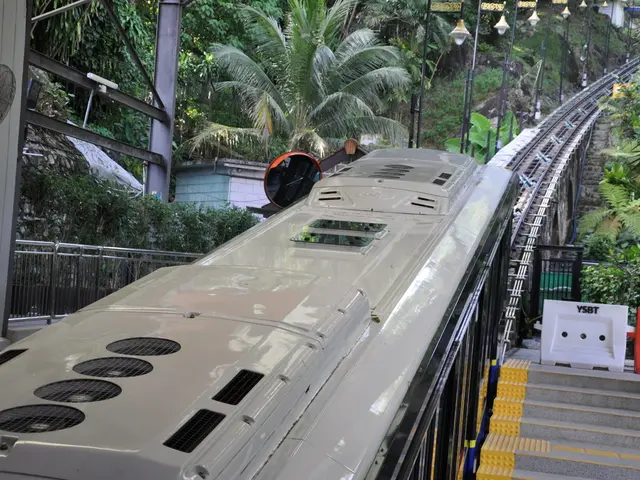EU's Deeper Game in Central Asia: An Unveiled Tech-Narrative
EU Remains Firm on Intensifying Interactions with Kazakhstan
ASTANA - The EU's recent encounter with President Kassym-Jomart Tokayev of Kazakhstan, in a bid to broaden and deepen its partnership with Central Asia, showcases a tech-driven game plan. Jozef Síkela, EU Commissioner for International Partnerships, spearheaded the meeting, emphasizing the EU's intent to engage more substantially with the region.
Tokayev, during the March 13 meeting, underscored Kazakhstan's role as a pillar in the EU's Central Asian strategy. He pointed out the Enhanced Partnership and Cooperation Agreement as a robust base to shape multifaceted interactions further.
The discussion skimmed practical issues, with a keen interest in existing and emerging economic projects focusing on transport corridors, logistics infrastructure, sustainable energy, and digital solutions. In a casual exchange of views, both parties expressed their preparedness to harmonize approaches for the forthcoming EU-Central Asia summit.
In the preceding hours, Kazakhstan and the EU had inked essential pacts under the Global Gateway Strategy, including a $3.3 million contract with the EBRD that strengthens critical raw materials cooperation and a $217.5 million framework loan agreement between the EIB and DBK, targeting sustainable transport and renewable energy.
These deals are fortified by a $19.6 million EU guarantee, playing a pivotal role in progressing the Trans-Caspian Transport Corridor and the Team Europe Initiative on Water, Energy, and Climate Change.
Behind the Scenes: The EU's Global Gateway Strategy
The EU's Global Gateway Strategy is a far-reaching initiative aiming to foster global connectivity through infrastructure development. The main focus is on transportation, energy, and technology sectors with paramount consideration for sustainability and climate action. This ambitious plan is part of the EU's efforts to bolster its worldwide influence and support its partner countries in achieving their developmental aspirations.
In terms of Kazakhstan, the Global Gateway Strategy excites various implications across transportation, energy, and digital solutions:
- Transportation:
- The strategy champions the development of transport infrastructure, essential for landlocked nations like Kazakhstan. This involves advancing connectivity through the Trans-Caspian International Transport Route (TITR), linking Central Asia to Europe via the South Caucasus, fostering commerce and economic integration[3].
- Enhancements in transport infrastructure can boost logistics efficiency and drive costs down, benefiting both domestic and international commerce.
- Energy:
- The EU's emphasis on energy within the Global Gateway Strategy echoes Kazakhstan's aspirations of modernizing its energy sector. Goals encompass supporting initiatives that propel energy security and champion renewable energy sources.
- Kazakhstan plays a crucial role in the regional energy market. Embracing cleaner energy sources aligns with global climate objectives.
- Digital Solutions:
- The strategy advocates digital connectivity and innovation, vital for Kazakhstan's economic modernization. This includes investments in digital infrastructure to support businesses and foster regional connectivity.
- Digital solutions are keystones to improving efficiencies in sectors like logistics and energy, as well as increasing overall economic competitiveness.
The Keystones: Cooperation and Funding
The European Bank for Reconstruction and Development (EBRD) fuels these efforts through financing and studies in the transport, energy, and trade connectivity sectors[1]. Furthermore, the EU's support for micro, small, and medium-sized enterprises (MSMEs) in Kazakhstan, through guarantee programs such as Growth4All, ensures local businesses capitalize on these investments[4].
Overall, the EU's Global Gateway Strategy sets out to trigger economic growth and development in Kazakhstan by enhancing connectivity and promoting sustainable practices across critical sectors. While the surface portrays a mere expansion of partnerships, the undercurrent tech-oriented approach promises far-reaching repercussions for the region.
- The EU's Global Gateway Strategy, amidst its focus on infrastructure development, addresses the importance of digital solutions in Kazakhstan's economic modernization, investing in digital infrastructure to support businesses and foster regional connectivity.
- In terms of transportation, the strategy advocates for the development of transport infrastructure in landlocked nations like Kazakhstan, such as advancing connectivity through the Trans-Caspian International Transport Route (TITR), linking Central Asia to Europe via the South Caucasus.
- The EU's Global Gateway Strategy, with a prime focus on energy, echoes Kazakhstan's aspirations of modernizing its energy sector. The strategy supports initiatives that propel energy security and champion renewable energy sources.
- The strategy's changes in policy-and-legislation, as represented by the Global Gateway Strategy, could impact various sectors like migration, war-and-conflicts, crime-and-justice, general-news, fires, and accidents, due to the far-reaching repercussions for the region that its undercurrent tech-oriented approach promises.








